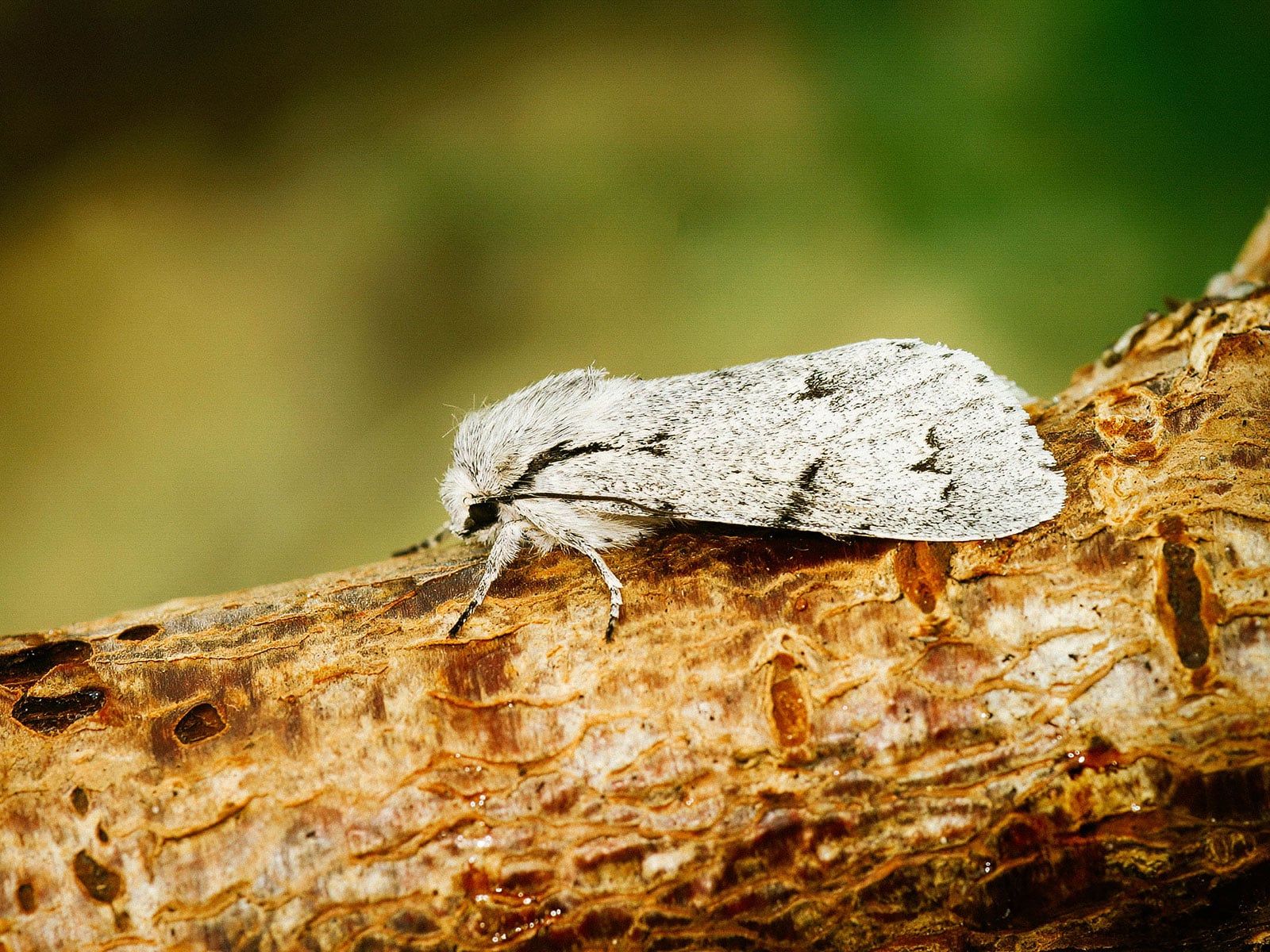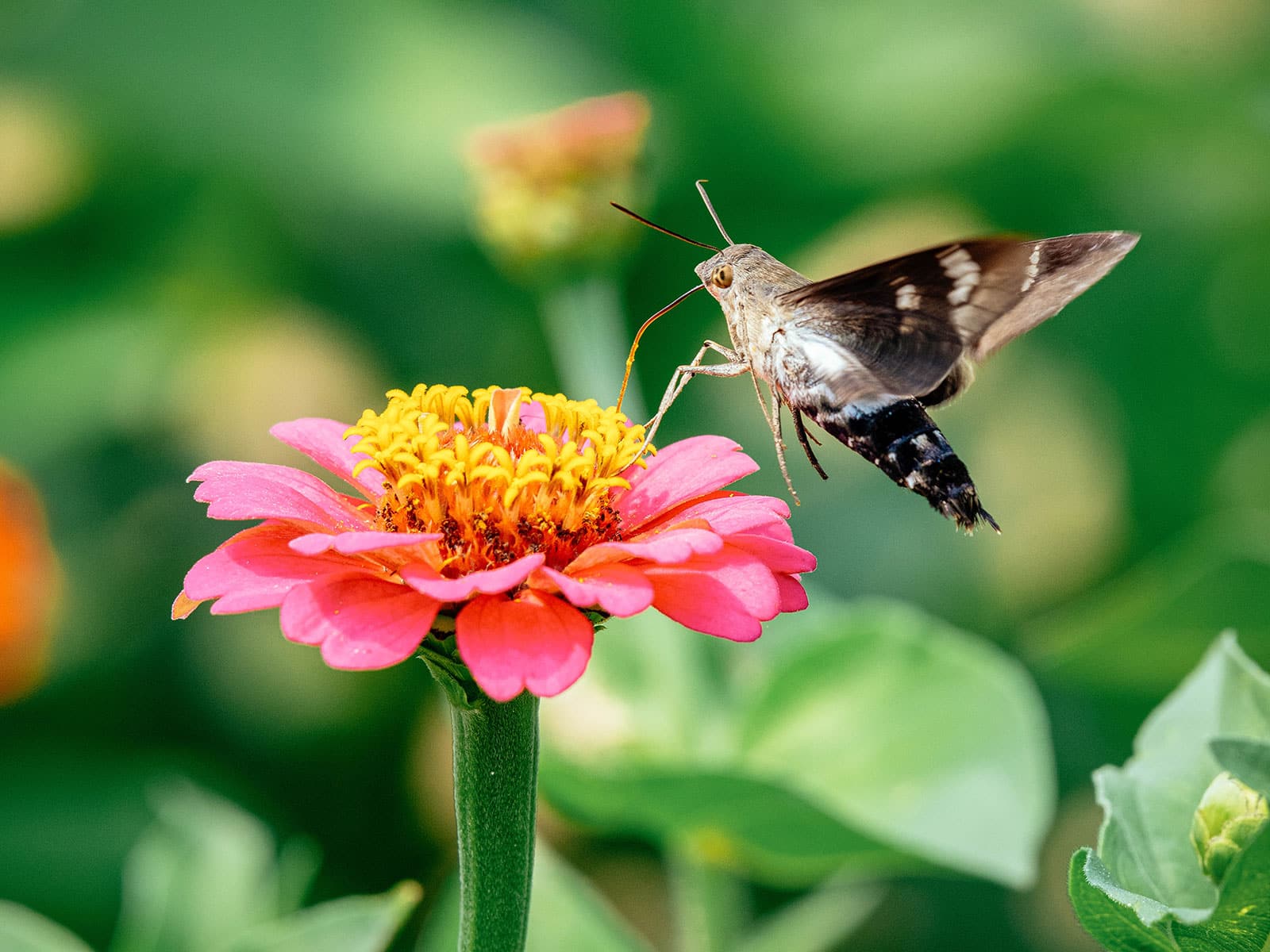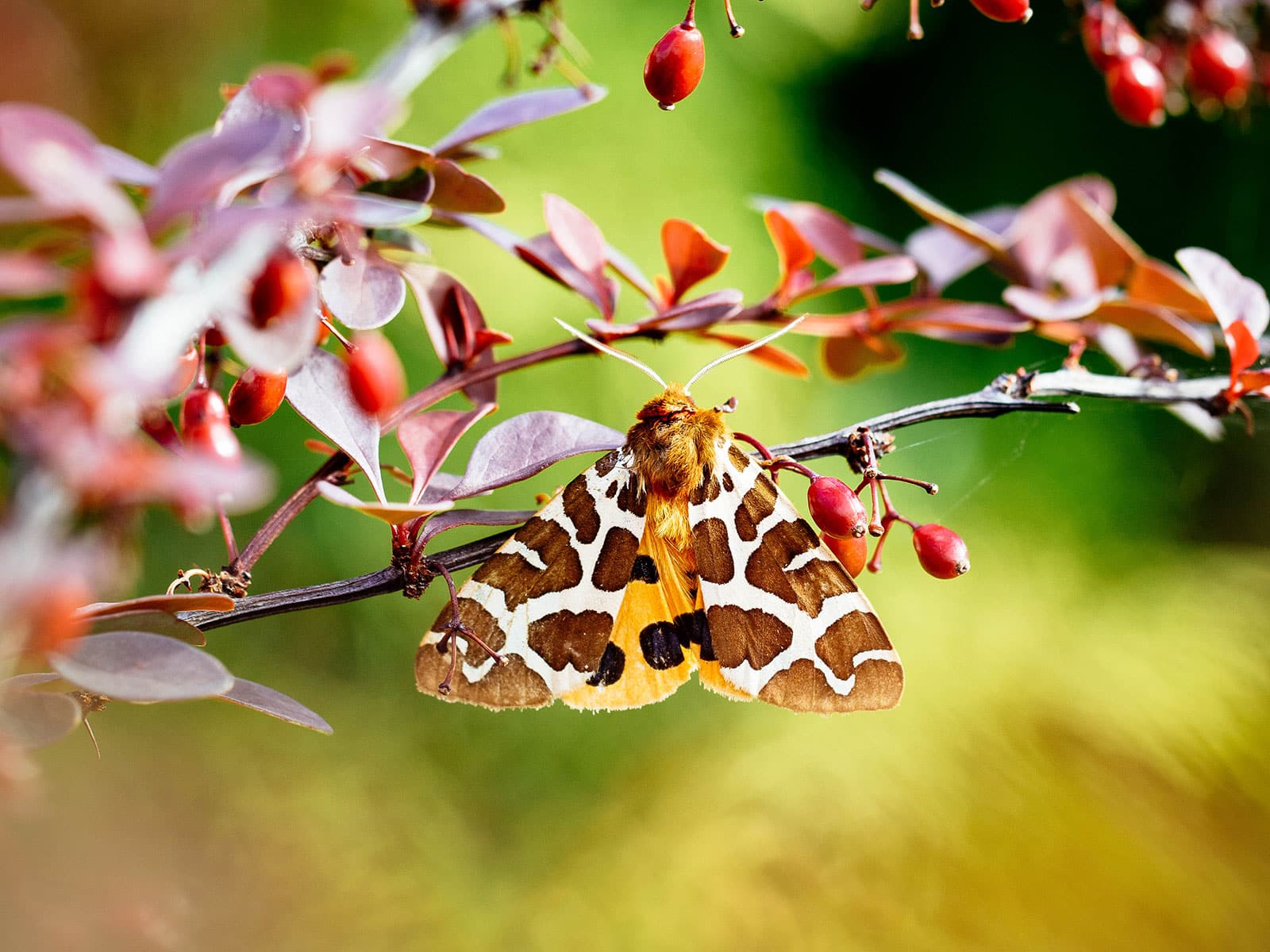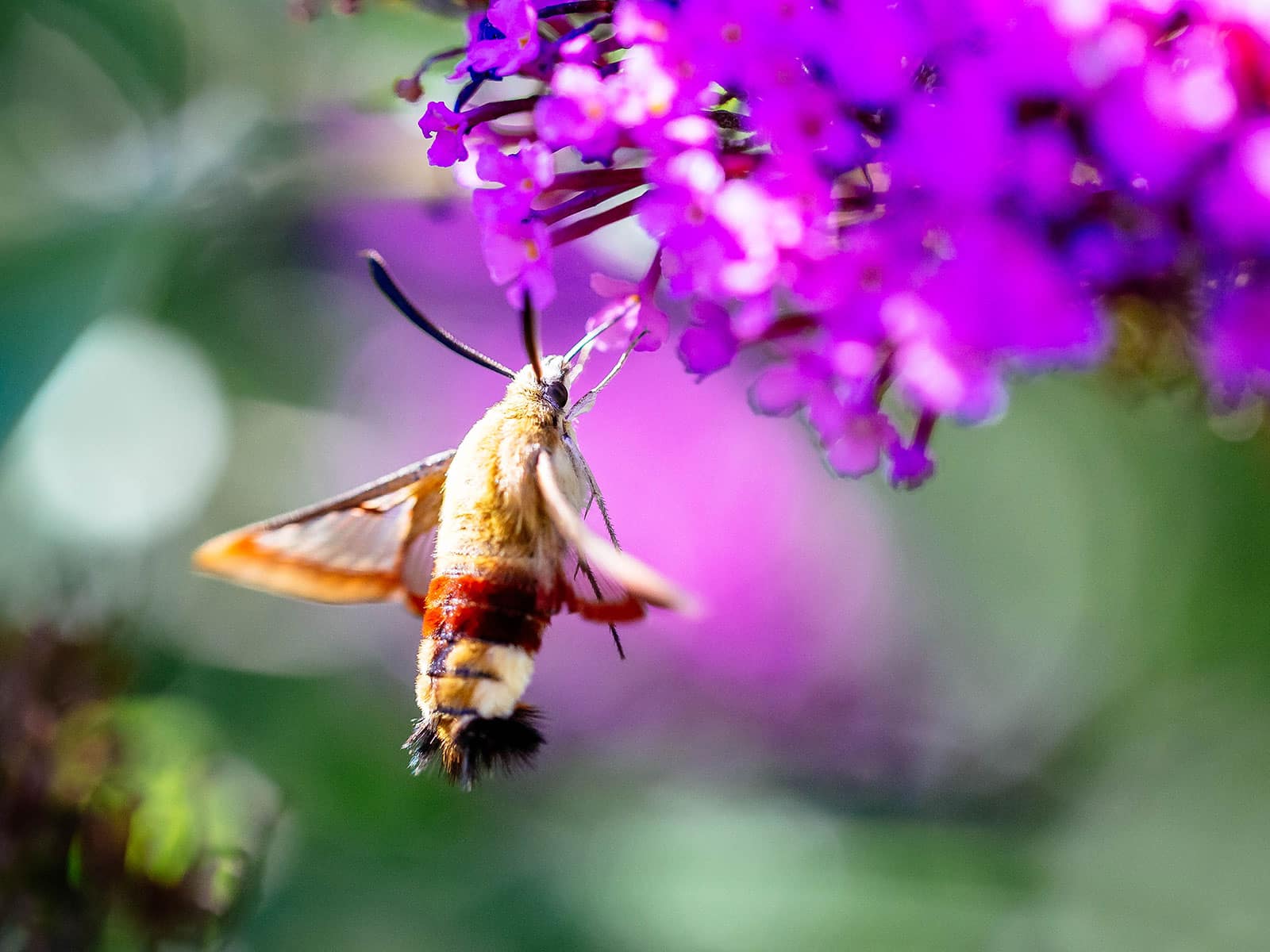Moths tend to get a bad rap as dusty pests that make holes in your sweaters or flap annoyingly against your outdoor lights. And while there’s a small percentage of moths that are considered invasive or harmful, many more are actually beneficial in the garden.
Think of moths as night butterflies (though many species are actually diurnal, fluttering around at the same times as butterflies). Many of these day-active moths are so large and colorful that they’re often mistaken for butterflies with their bold patterned wings, and even the most drab-colored moths are actually quite beautiful when you get up close.

But beauty is not the only reason you want moths in your garden. These highly underestimated insects play a vital role in the ecosystem, among them:
Pollination
Moths are important pollinators, particularly those that are active after dark (a time when most other pollinators have turned in for the night). Their diverse taste in flowers make them a critical backup to bees and other pollinators working the day shift, as they support plant species that bees often ignore.
One study has found that nocturnal moths visit more plant species at night than bees do during the day, including some plants that bees skip completely! (And that’s quite a feat considering the superpollinator status that bees tend to have.)
Sphinx moths and hawk moths from the family Sphingidae are notably efficient. Night-blooming flowers, in particular, depend on them, including moonflowers, evening primrose, flowering tobacco, four o’clocks, night-blooming cereus, and certain species of squash.
As a food source
Stumbling, clumsy moths and their caterpillars are relatively easy for predators to catch. They make a good food source for all sorts of backyard critters, especially those that help control actual garden pests like aphids and earwigs. After all, if you want to keep these predatory animals around, you have to make sure you have enough food for them!
Small wildlife that like snacking on moths and their caterpillars include:
- Birds
- Bats
- Insects (like dragonflies and praying mantises)
- Spiders
- Hedgehogs
- Reptiles (like geckos)
- Amphibians (like frogs)
For pest control
Sorry, what? Moths as pest control? Yes! It may come as a surprise, but the caterpillars of some moths are actually parasitic. A few feed on other bugs that we tend to consider pests.
One example that’s native to the US is planthopper moths from the genus Epipyropidae. Their caterpillars attach themselves to planthoppers (insects that consume plant sap and can damage crops) and slowly suck their juices.

How to attract moths
Have I managed to convince you to make your backyard a hospitable place for moths? I hope so! There are plenty of things you can do to attract these (mostly) nocturnal insects.
Grow nectar plants that moths like
Moths are attracted to many of the same flowers that bees, butterflies, and hummingbirds love.
Read more
But you can take it one step further and plant a little night garden to attract more moths. After all, some flowers bloom only at night, and many of these specifically depend on moths for pollination.
Attract nectar-loving sphingid moths with night-bloomers like:
- Evening primrose (Oenothera sp.)
- Moonflower (Ipomoea alba)
- Flowering tobacco (Nicotiana sp.)
- Yucca (the Yucca species has its own genus of moths, known as Tegeticula)
- Night-blooming cacti like Cereus and Epiphyllum
And by the way, not all plants for moths have to bloom at night. Flowers like honeysuckle, milkweeds, and the butterfly bush (Buddleja) provide nectar for day-flying moths, while other flowers like gardenias bloom during the day but emit more fragrance at night in order to attract nocturnal moths.
Did you know?
Scientists widely agree that many moth species are on the decline. Helping out your local moth species is more important than ever!
Grow moth caterpillar host plants
If you want to attract moths, don’t just consider the adults. Keep the caterpillars in mind as well! Growing a variety of host plants for moth larvae to feed on will allow them to complete their entire life cycle right in your own yard.
Some plants that are appreciated by a range of different caterpillars include:
- Milkweed (yep, it’s not just butterflies that love it!)
- Willow trees
- Oak trees
- Nettles (also popular with butterflies)
- Cherry trees
- Dill
- Clover
Avoid bug zappers
Did you know that, unlike what a lot of people think, bug zappers don’t attract mosquitos? Unfortunately, these zappers mostly kill beneficial insects. This includes moths, which are highly attracted to the ultraviolet light.
Sure, it’s nice to not have all sorts of bugs flying around your head while you sit on the deck at night, but bug zappers tend to do more harm than good. So, turn off the zapper and use other proven methods for reducing mosquito bites: eliminating standing water, wearing colors they can’t see well (including white and cool-toned pastels), or using topical repellents.
Don’t keep your garden too clean
This one’s important for lots of critters you want to keep around in a garden, not just moths. Some piles of leaves here and there, plants growing a little wild, and weeds left to do their thing help support a variety of backyard wildlife, including birds, lizards, frogs, and predatory insects.
An untidy garden offers:
- Shelter, including warm spots suitable for overwintering
- Plenty of food sources, especially early or late in the season
- Microclimates, such as spots that are extra humid
- Food in the form of decaying plants
- Spots to safely lay eggs

Common questions about moths
Do moths bite?
Nope! You can carefully pick up or touch any moth you find (though you should avoid contact with the spiky caterpillars).
Why are moths attracted to light?
This phenomenon is called positive phototaxis. Most moths are attracted to light, and it isn’t entirely clear why. It’s also unclear why they’re more attracted to some light wavelengths, like UV light.
The most popular theory is that moths use the moon to navigate, which is why our street lamps and campfires confuse them so much.
What are the differences between butterflies and moths?
Once you know what to look for, it’s easy to tell the difference between butterflies and moths at a glance. Both belong to the scientific order Lepidoptera and have fragile, often colorful wings.
However, there are also plenty of differences:
- Moths: Generally nocturnal, fuzzy, more muted colors, have feathery antennae, and keep their wings in an open position at rest.
- Butterflies: Generally diurnal and with a thinner, less hairy body. Often more brightly colored, long antennae with clubs at the end, and keep their wings in a closed position at rest.















